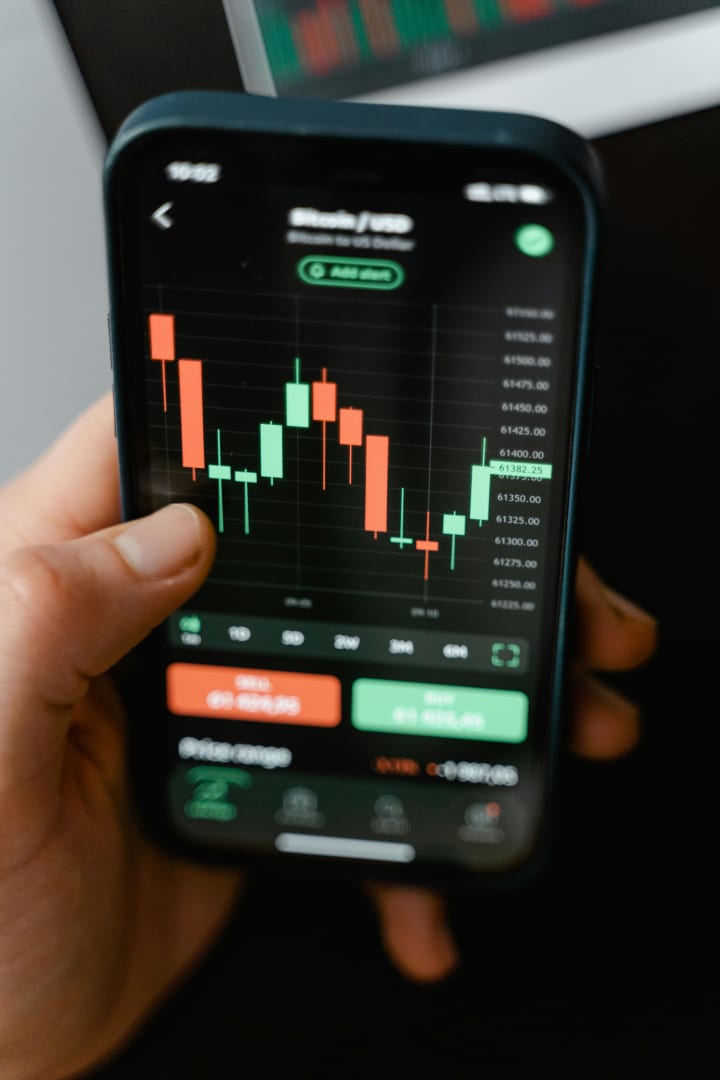How to Implement Dollar Cost Averaging in Crypto Investing
Learn How Dollar Cost Averaging Can Improve Your Crypto Investments

In the volatile world of cryptocurrency investing, risk management strategies have never been more critical. Among these strategies, dollar cost averaging (DCA) stands out as a methodical approach that can help to mitigate risk and potentially smooth out the volatility inherent in the crypto market. By investing a fixed amount of money into a cryptocurrency at regular intervals, regardless of its price, investors can possibly reduce the impact of market fluctuations on their investment portfolio. Understanding and implementing dollar cost averaging in crypto investing is essential for anyone looking to navigate the turbulent waters of the digital currency market with a degree of composure.
This article delves into the nuances of dollar cost averaging, outlining its significance in the realm of crypto investing and why it's a recommended strategy for risk management. Beginning with a clear explanation of what DCA in crypto entails, it progresses to discuss the multiple benefits of incorporating this strategy into your investment portfolio. Readers will learn how to set up a dollar cost average plan, select the right cryptocurrency for DCA, and explore various examples of DCA strategies. Additionally, the article aims to shed light on real-world examples of DCA in crypto, common mistakes to avoid, and concluding thoughts on how this strategy can play a pivotal role in one's crypto investment journey.
What is Dollar Cost Averaging (DCA)?
Dollar Cost Averaging (DCA) is an investment strategy designed to diminish the effects of market volatility by systematically investing a predetermined amount of money into a particular asset at regular intervals, regardless of the asset's price at those times. This method not only facilitates a disciplined investing approach by making the investment process automatic but also helps in averaging the purchase price of the asset over time. By consistently investing, an individual can potentially lower the average cost per unit of the asset, which could lead to significant savings and reduced impact of market fluctuations on the overall investment.
Definition and Basic Concept
Dollar-cost averaging involves committing the same amount of money at regular intervals to purchase a security, irrespective of its price. When prices are low, more shares can be bought with the same amount of money, and when prices are high, fewer shares are purchased. This strategy can be particularly effective in volatile markets like cryptocurrencies, where substantial price swings are common. By applying DCA, investors can avoid the pitfalls of trying to time the market to make large, sporadic investments. Instead, they benefit from the market's natural up and down movements over time, which may lead to a lower average cost per share.
History and Origins
The term "Dollar Cost Averaging" was first coined by Benjamin Graham, often referred to as the father of value investing, in his seminal work, The Intelligent Investor. Graham advocated for this approach as a means of reducing the average cost of shares purchased, thereby achieving a more favorable overall price for an investment portfolio over time. This technique has been embraced widely, particularly in long-term investment plans like 401(k)s, where fixed sums of money are invested regularly regardless of the market's condition. This not only simplifies the investment process but also aligns with the long-term financial goals of building wealth gradually and avoiding emotional investing decisions.
By integrating DCA into their investment strategies, both novice and experienced investors can leverage a disciplined and less emotionally driven approach to building and managing their portfolios. This strategy is particularly advantageous for those who may not have the time or expertise to monitor market fluctuations closely and make timely investment decisions.
Why Use Dollar Cost Averaging in Crypto Investing?
Dollar Cost Averaging (DCA) is a strategy that offers a robust solution to the challenges posed by the volatile nature of the cryptocurrency market. By investing a fixed amount of money into cryptocurrency at regular intervals, investors can mitigate the risks associated with the dramatic price fluctuations typical of crypto markets.
Reducing the impact of volatility
The crypto market is known for its sharp price movements, often driven by speculative trading and external news events, which can lead to significant financial losses for investors who buy at market peaks. The DCA method helps in smoothing out these fluctuations over time. By consistently investing a predetermined amount, investors can purchase more cryptocurrency when prices are low and less when prices are high. This averaging effect over time helps in reducing the average cost per unit of the cryptocurrency purchased, potentially leading to improved returns as markets rise over the long term.
Avoiding the pitfalls of market timing
Attempting to time the market can be a risky strategy, especially in a market as unpredictable as crypto. The allure of buying low and selling high is strong, but the timing of market movements can be nearly impossible to predict accurately, often leading to missed opportunities or substantial losses. Dollar Cost Averaging eliminates the stress and uncertainty of trying to time the market. By investing fixed amounts at regular intervals, investors do not need to worry about buying at the absolute lowest point or selling at the peak. This method not only simplifies the investment process but also promotes a more disciplined, long-term approach to investing.
Furthermore, DCA is particularly beneficial during the tumultuous periods known as 'crypto bubbles,' where the market prices inflate rapidly and are often followed by a significant drop. Regular, disciplined investment through DCA during these times allows investors to buy more at lower prices after a bubble bursts, setting a foundation for potential gains when the market stabilizes and recovers.
In conclusion, Dollar Cost Averaging in crypto investing provides a systematic approach to building an investment portfolio in a highly volatile environment. It reduces the emotional stress associated with significant market fluctuations and helps in crafting a more resilient and potentially profitable investment strategy.
How to Set Up a Dollar Cost Averaging Plan
Implementing Dollar-Cost Averaging (DCA) in your crypto investment strategy is a straightforward method to build your portfolio over time. This section outlines the essential steps to set up a DCA plan that aligns with your investment goals and risk tolerance.
Determine your investment amount and frequency
The first step in establishing a DCA plan is to decide on the frequency and amount of your investments. This decision should reflect your financial situation, risk tolerance, and investment objectives. Common frequencies for investment include weekly, bi-weekly, or monthly contributions. The amount you choose should be sustainable over the long term without compromising your financial health. By maintaining a consistent investment schedule, you can mitigate the effects of market volatility and benefit from the potential long-term growth of the cryptocurrency market.
Choose a cryptocurrency exchange
Selecting the right platform is crucial for implementing your DCA strategy. Look for exchanges that offer user-friendly features for setting up recurring purchases, such as Coinbase, Binance, or Kraken. These platforms allow you to automate your purchases at regular intervals, which is essential for maintaining discipline in your investment strategy. Additionally, consider the security, transaction fees, and the range of cryptocurrencies offered by the exchange to ensure it meets your investment needs.
Set up automated purchases
Automating your investment process is key to a successful DCA strategy. Many cryptocurrency exchanges and investment platforms provide options to set up recurring buys for specific cryptocurrencies. Link your bank account or credit card to the platform to automate purchases according to your predetermined schedule and amount. This not only saves time but also eliminates the emotional aspect of investing, allowing you to stick to your investment plan without being swayed by market fluctuations.
By following these steps, you can effectively implement a Dollar-Cost Averaging strategy in your crypto investments, which can help in smoothing out purchase prices over time and potentially lower the average cost per unit of the asset.

Choosing the Right Cryptocurrency for DCA
Choosing the right cryptocurrency for dollar-cost averaging (DCA) is a critical decision that can significantly impact the success of your investment strategy. This choice should be informed by a thorough understanding of the market trends, the stability of the cryptocurrency, and your long-term investment goals.
Factors to Consider (Market Cap, Stability, etc.)
When selecting a cryptocurrency for DCA, investors should first consider the market capitalization and stability of the asset. Cryptocurrencies with a higher market cap, such as Bitcoin and Ethereum, generally offer more liquidity and less volatility compared to smaller altcoins. This makes them preferable choices for DCA, as they are likely to be more resilient in the face of market fluctuations.
Investors should also assess the historical price performance and the longevity of the cryptocurrency in the market. Assets that have shown consistent growth or stability over several market cycles may offer a safer bet for long-term investments. Additionally, understanding the fundamentals of the cryptocurrency, including the project’s goals, the team behind it, and its technological infrastructure, can provide valuable insights into its potential for future growth and sustainability.
Popular Cryptocurrencies for DCA (Bitcoin, Ethereum, etc.)
Bitcoin (BTC) and Ethereum (ETH) are among the most popular choices for implementing a DCA strategy. Both cryptocurrencies have established a significant presence in the market and have been through multiple cycles of highs and lows, which provides a larger data set for investors to analyze their long-term viability.
Bitcoin, often referred to as digital gold, has not only shown resilience but has also reached new highs in each market cycle, making it a prime candidate for DCA. Ethereum, known for its smart contract functionality, continues to play a pivotal role in the development of decentralized applications, suggesting a strong potential for growth.
For investors looking at options beyond Bitcoin and Ethereum, it is crucial to conduct a deep dive into the altcoins being considered. Factors like tokenomics, project utility, and community support should be evaluated. Additionally, monitoring metrics such as trading volume and liquidity can aid in understanding the market’s sentiment towards the asset.
Investors should also be aware of the risks associated with DCA in cryptocurrencies, especially with smaller or less established altcoins. Many altcoins may not recover their value during market downturns, leading to potential losses. Therefore, choosing a cryptocurrency with a proven track record and a clear long-term potential is advisable.
By carefully selecting the right cryptocurrency and aligning it with a well-thought-out DCA strategy, investors can potentially reduce the impact of volatility and build a robust investment portfolio over time.
Examples of Dollar Cost Averaging Strategies
Dollar-cost averaging (DCA) is a strategic approach to investing that involves regularly purchasing a fixed dollar amount of a particular asset, such as cryptocurrency, at scheduled intervals—regardless of the asset's price at those times. This method can help investors mitigate the risks associated with market volatility and avoid the pitfalls of trying to time the market. Here are two common strategies that illustrate how DCA can be implemented in crypto investing:
Fixed Interval Strategy
One popular method of implementing dollar-cost averaging is the fixed interval strategy. This approach involves investing a predetermined amount of money into a cryptocurrency at regular, fixed intervals. For example, an investor might choose to invest $100 in Bitcoin on the first day of every month, regardless of Bitcoin’s current price. This strategy simplifies the investment process, as it automates buying and reduces the emotional stress associated with market fluctuations. It allows investors to take advantage of market dips over time without the need to predict market movements.
Another variant of this strategy could involve investing a percentage of one's biweekly paycheck into a cryptocurrency like Ethereum. By consistently allocating a small portion of income, investors can gradually build their holdings while spreading out the cost of investment. This method is particularly beneficial for individuals who prefer a set-and-forget approach to investing, ensuring they are consistently investing without needing to actively monitor the market.
Volatility-based Strategy
The volatility-based strategy adjusts the dollar amount invested based on the cryptocurrency's recent price changes. If the price of the cryptocurrency has dropped significantly since the last investment interval, the strategy might call for investing a higher dollar amount to purchase more coins at a lower price. Conversely, if the price has increased significantly, the strategy might reduce the amount invested.
For instance, consider a scenario where an investor plans to invest in a new token, $PLS. Instead of investing a lump sum, the investor decides to divide their investment into smaller portions over several months. If the price of $PLS drops, the investor buys more tokens with their allocated funds, taking advantage of the lower prices. This method not only averages out the investment cost over time but also aligns the buying strategy with market performance, potentially maximizing returns when the market recovers.
Both strategies demonstrate the flexibility and effectiveness of dollar-cost averaging in managing investment risks, particularly in the volatile cryptocurrency market. By implementing these strategies, investors can potentially lower their average cost per coin, thereby improving their long-term investment outcomes. This systematic approach to investing helps in building a robust portfolio by leveraging the market's natural ups and downs, making it a favored choice among both novice and experienced investors.
Explore another valuable investment alternative for these uncertain times.
Real-World Examples of DCA in Crypto
Case study 1: Buying during a bull market
During the bull market that peaked in late 2017, Bitcoin reached an all-time high of approximately $19,900. Investors who applied dollar-cost averaging (DCA) during this period experienced significant benefits. For instance, an investor consistently purchasing $100 worth of Bitcoin on the 17th of each month, starting from December 17, 2017, would have accumulated about 0.48 BTC by the end of the period, with an average purchase cost of around $8,660. This strategy yielded nearly a 120% gain at a market price of $18,850, demonstrating the effectiveness of DCA in mitigating risks associated with price volatility and market timing.
Case study 2: Buying during a bear market
The financial crisis of 2008 presents a notable example of how DCA can be advantageous during bear markets. Investors who consistently invested through the 2007-2009 downturn saw their portfolio values decrease initially but gradually recover and grow as the market stabilized. This contrasts sharply with those who withdrew their investments during the market's lowest points, resulting in significant financial setbacks. DCA provided a structured approach to investing during this tumultuous period, allowing investors to buy more shares at lower prices, thereby reducing the average cost per share and setting a strong foundation for future gains as the market recovered.
These real-world examples underscore the resilience of the DCA strategy in different market conditions, emphasizing its role in reducing the impact of emotional decision-making and market timing errors. By committing to regular, predefined investments, investors can navigate through market highs and lows with a disciplined approach that potentially leads to substantial long-term benefits.
Common Mistakes to Avoid with DCA
Investing in cryptocurrencies using the dollar cost averaging (DCA) strategy can be an effective way to build a portfolio while mitigating risk. However, certain common mistakes can undermine the benefits of this strategy. Here are some pitfalls to avoid:
Investing too much at once
A frequent error is the temptation to invest heavily when the market appears favorable. For example, an investor might impulsively decide to invest a significant portion of their net worth in Bitcoin due to fear of missing out (FOMO) on potential gains. This was the case with Davey, who, driven by excitement, invested 10% of his net worth in Bitcoin right before a substantial drop in price, leading to a panic sale at a loss. Such actions contradict the fundamental principle of DCA, which is to invest smaller, fixed amounts regularly, thus avoiding substantial financial damage during downturns.
Not sticking to the plan
DCA requires discipline and a long-term perspective. Some investors, like Ben, start a DCA plan but struggle to maintain their strategy, especially when market prices soar or plummet. The allure of quick profits or the fear of increasing losses can prompt deviations from the set plan. However, maintaining consistency in investments, regardless of market conditions, helps in averaging the purchase cost over time and potentially reduces the impact of volatility. Ben's experience during the 2021 bull market highlights the importance of resisting the urge to alter one's investment strategy amidst market hype.
Investors should also be wary of several other pitfalls:
Inadvertent Diversification: Concentrating on just one or two cryptocurrencies can expose investors to higher risks if those currencies underperform. Diversifying across various assets with different use cases and growth potentials can mitigate such risks.
Insufficient Research: It's crucial to thoroughly understand the cryptocurrencies one plans to invest in. Relying solely on market trends or popular opinions without a solid grasp of the underlying fundamentals can lead to poor investment choices.
Lack of Flexibility: While consistency is key, being overly rigid can be detrimental. Adapting one's strategy in response to prolonged market changes, like a bear market, can be prudent. This might involve temporarily reducing investment amounts or adjusting the portfolio to include more stable assets.
Overlooking Costs and Fees: Since DCA involves frequent transactions, the associated fees can accumulate and impact overall returns. Choosing platforms with competitive fees is essential to maximize the effectiveness of a DCA strategy.
By avoiding these common mistakes, investors can better leverage the advantages of dollar cost averaging, making it a powerful tool for building a resilient and profitable cryptocurrency portfolio.

Conclusion
Throughout this article, we've explored the nuanced strategy of Dollar Cost Averaging (DCA) within the realm of crypto investing, providing a systematic approach aimed at curbing the risks tied to the inherent volatility of the cryptocurrency market. By delving into the fundamental aspects, benefits, and practical steps for implementing DCA, alongside real-world examples and common pitfalls, the article has underscored the value of this investment strategy in fostering a disciplined, less emotionally driven approach to portfolio building. The discussion illuminated how DCA functions as a pivotal mechanism for investors, offering a pathway to potentially smoother investment journeys by mitigating the impact of price fluctuations and market timing errors.
As we've navigated through DCA's strategic importance and its application in crypto investing, it's evident that the method stands as a cornerstone for individuals looking to invest with a long-term perspective. The insights shared herein not only highlight the significance of adhering to a structured investment plan but also underscore the broader implications of DCA in cultivating a more resilient investment portfolio amidst the crypto market's dynamic landscape. For those embarking on or navigating through their investment journey, the principle of regular, disciplined investment remains a beacon, guiding towards potentially optimized financial outcomes. As we conclude, it's pivotal to bear in mind the broader perspective of crypto investing—as a field teeming with opportunities yet fraught with challenges, where strategies like DCA offer a semblance of stability and strategic foresight.
Explore another valuable investment alternative for these uncertain times.
FAQs
1. How effective is cost averaging in cryptocurrency investments?
Dollar-cost averaging in cryptocurrency can be effective if you believe the asset will appreciate over time. Major cryptocurrencies like Bitcoin (BTC) and Ethereum (ETH) have historically reached new highs in each market cycle. However, it's important to remember that past performance does not necessarily predict future results.
2. How do you calculate dollar-cost averaging (DCA) for cryptocurrencies?
To calculate the dollar-cost average for your cryptocurrency investments, divide the total amount spent on the assets by the total number of tokens you have purchased. The formula is: Total cost divided by total number of tokens equals the dollar-cost average.
3. What does dollar-cost averaging mean in the context of a crypto wallet?
Dollar-cost averaging (DCA) in a crypto wallet is a strategy that involves purchasing more tokens when prices are low and fewer tokens when prices are high. This method helps align your investments with market growth and can lead to opportunities for value appreciation over the long term.
4. What are the advantages of using the DCA strategy in cryptocurrency investing?
The dollar-cost averaging strategy helps reduce the effects of market volatility and can lower the average cost per share over time. This approach is particularly advantageous for both novice and long-term investors, as it removes the need to precisely time the market for making purchases.
About the Creator
Antonio Ramirez Martinez
Passionate collaborator dedicated to sharing useful and trending information. I believe in the power of collaboration to bring valuable insights to the forefront. Let's connect and explore the latest trends together.






Comments (1)
Thank you for your interesting and exciting stories. Follow my stories now.